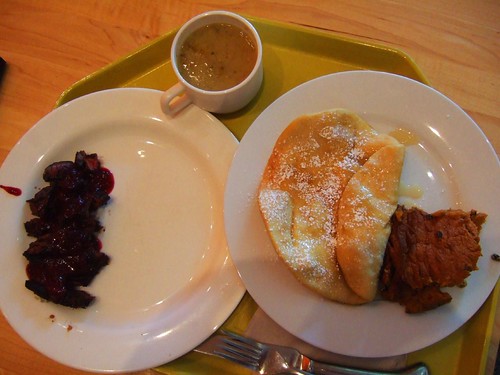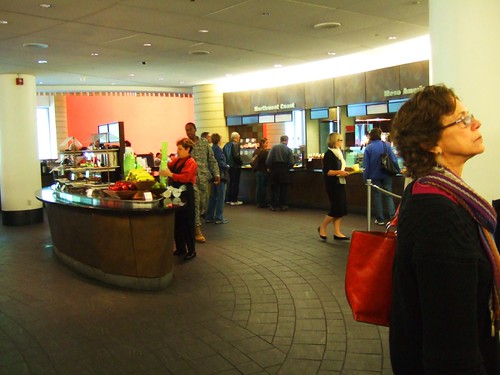 Map of Tenochtitlan from the Letters of Hernan Cortes to Charles V, 1524. Library of Congress.
Map of Tenochtitlan from the Letters of Hernan Cortes to Charles V, 1524. Library of Congress.
We stood in front of a modern day market–one that sold kinda cheesy, but loveable, tourist goods–and our guide pointed to a map. “In Tenochtitlan, we would be standing here, on the site of the market.” A modern day market was on top of a historic one, the latter buried somewhere beneath our feet.
For our honeymoon, my husband and I traveled to Mexico, and we spent the first half of our trip in the capital city. Mexico City sits on the historic site of Tenochtitlan (1325-1521), the Aztec/Mexica capital city and one of the last great Central American cities to fall under Spanish Colonial rule. Famously built on top of a lake, where an eagle clutching a serpent stood on a cactus on a swampy isalnd, it was a highly defendable collection of man-made islands veined by canals. Now, each island roughly corresponds to a different neighborhood in the city (although Mexico City is far larger today); in many circumstances, Spanish colonials built buildings right on top of existing native structures.
 Mexico City: In the foreground,the ruins of Tenochtitlan’s Templo Mayor; in the background, Spanish Colonial buildings.
Mexico City: In the foreground,the ruins of Tenochtitlan’s Templo Mayor; in the background, Spanish Colonial buildings.
On our first full day in the city, we took a tour with Eat Mexico who provide food walking tours geared towards English speakers. I loved the four-hour tour of markets and street food because I feel like it gave us our Mexican food training wheels–we learned what dishes were called, what we liked, and from that point on we were unafraid to pull up our seats to a street food cart and dig in. But I also had a sort of historical revelation as we stood in the market.
Our guide, “Paco,” mentioned that we knew there was a market here in Tenochtitlan because there is a written account of it: a lengthy letter that Hernan Cortez sent to Charles V. The letter is fascinating, and can be read in its entirity here. But of course the part I find most interesting is his description of Tenochtitlan’s largest market, the one that was below my feet:
There is one square…where are daily assembled more than sixty thousand souls, engaged in buying and selling ; and where are found all kinds of merchandise that the world affords, embracing the necessaries of life, as for instance articles of food…There is a street for game, where every variety of birds found in the country are sold, as fowls, partridges, quails, wild ducks, fly-catchers, widgeons, turtle-doves, pigeons, reedbirds, parrots, sparrows, eagles, hawks, owls, and kestrels ; they sell likewise the skins of some birds of prey, with their feathers, head, beak, and claws. There are also sold rabbits, hares, deer, and little dogs, which are raised for eating and castrated. There is also an herb street, where may be obtained all sorts of roots and medicinal herbs that the country affords. There are… restaurateurs, that furnish food and drink at a certain price… There are all kinds of green vegetables, especially onions, leeks, garlic, watercresses, nasturtium, borage, sorel, artichokes, and golden thistle ; fruits also of numerous descriptions, amongst which are cherries and plums, similar to those in Spain ; honey and wax from bees, and from the stalks of maize, which are as sweet as the sugar-cane; honey is also extracted from the plant called maguey, which is superior to sweet or new wine ; from the same plant they extract sugar and wine, which they also sell…maize, or Indian corn, in the grain and in the form of bread, preferred in the grain for its flavor to that of the other islands and terra-firma ; patés of birds and fish ; great quantities of fish, fresh, salt, cooked and uncooked ; the eggs of hens, geese, and of all the other birds I have mentioned, in great abundance, and cakes made of eggs;, finally, every thing that can be found throughout the whole country is sold in the markets, comprising articles so numerous that to avoid prolixity, and because their names are not retained in my memory, or are unknown to me, I shall not attempt to enumerate them.
And much, much more. There were even “persons who go constantly about among the people observing what is sold, and the measures used in selling; and they have been seen to break measures that were not true.”
The little, castrated dogs for eating are generally thought to be Chihuahuas, which recent DNA testing has deemed a “native dog”: one of a handful of species that did not come to the Americas with Europeans, but by an earlier Asian migration. And the “maguey” plant is agave; the agave “wine” they’re selling is pulque.
For more reading on Central American culture, I recommend 1491: New Revelations of the Americas Before Columbus. I read it right before my trip and it BLEW MY MIND.




